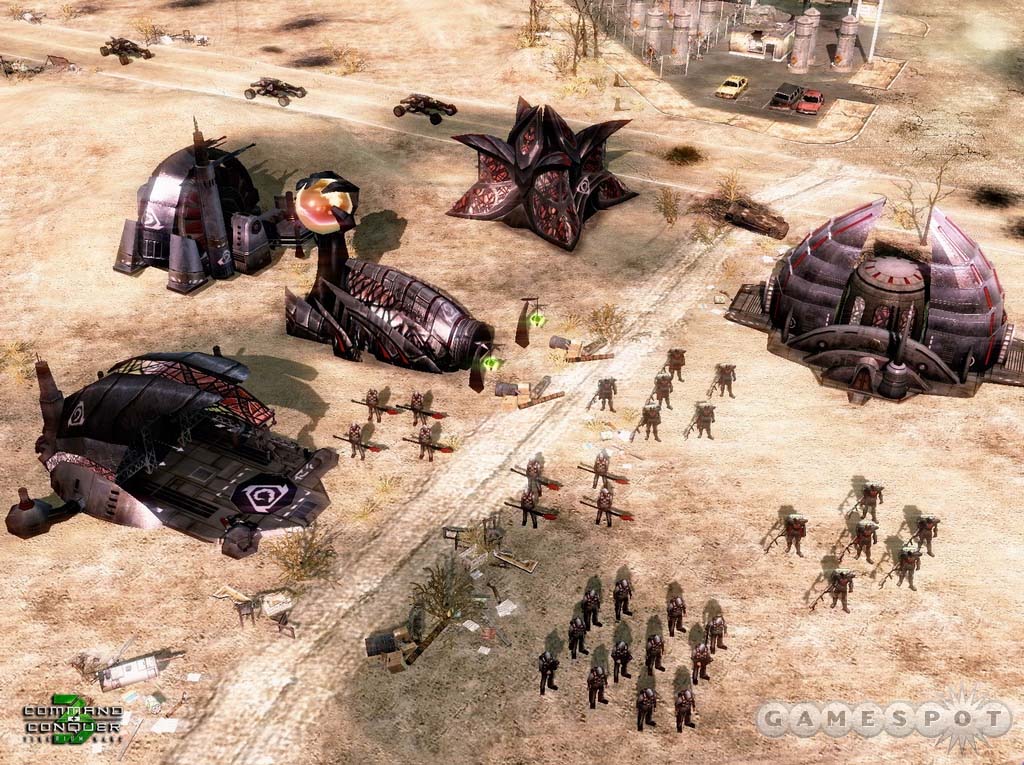
The Brotherhood of Nod features flexible guerrilla warfare forces, using stealth and Tiberium-based weaponry, though they are typically weaker. GDI's special weapon is the Ion Cannon, an orbital laser-guided energy strike. The Global Defense Initiative fights with conventional modern weapons and tactics, utilizing both technologically advanced armor and firepower, making them typically more destructive in open confrontations, but more cumbersome. There are three factions playable in the game. Once used, the timer must expire again before the superweapon can be activated for an additional time. A highly destructive superweapon for each faction can also be constructed and used after a certain timer expires. Production and construction may become temporarily blocked if the required structures are destroyed, or if they are not provided with adequate power by the supporting " power plant" structures. Virtually every type of structure in the game acts as a tech tree and additional units, structures and faction-specific abilities will become available to research and create as new structures are built. Unit effectiveness against opponents follows the rock-paper-scissors principle found in most real-time strategy games. Units can be classified into infantry, vehicles and aircraft, each with their own specialities. However, they are adjusted to fit each faction's theme and have somewhat varying properties. Base defense is provided by specialized defensive towers which are placed within a structure's territory.Īll three factions have structures and units with similar functions at their disposal. Other neutral structures, such as an EMP weapon, are also present on maps to be captured. Certain maps also feature Tiberium spikes, which, when captured by the faction's engineer unit, allocate a certain number of funds per second. The crystals are gathered by harvester vehicles which unload their cargo into refineries, supplying the player with credits which are then automatically used when training units and building structures. Tiberium is the sole resource and is usually gathered from fields of Tiberium crystals scattered around the map.

When a structure is built, the player can select anywhere near an existing structure to place it, gaining more territorial control. Though these simultaneously save time, funds are deducted for the extra cost as well careful management of production, training units and funds are key to strategy. Thus, when multiple production structures of the same type, such as cranes and barracks, are built, the player is given more queues from which to train and produce units and structures. Typically the player's primary goal is to defeat an enemy by assaulting and destroying their base, while defending their own.Ī supporting structure, a crane, can be constructed which can also construct structures. Certain structures can then produce units and resources are needed in order to fund the continuous building of structures and units. The construction yard, a movable base, is the central platform from which the player constructs other structures. The player oversees the action, ordering multiple units to move and attack targets.

The game received favorable reviews, and proved a commercial success following its launch, with a stand-alone expansion pack released a year later on March 24, 2008, titled Command & Conquer 3: Kane's Wrath.Ĭommand & Conquer 3 features returning aspects of gameplay from the previous series. Other modes include a skirmish battle mode and multiplayer games. The game brought about several changes in gameplay, some introduced in Command & Conquer: Red Alert 2, including garrisonable structures, neutral tech buildings, unit upgrades and veteran levels, and special powers unique for each playable faction. The game's story sees the Global Defense Initiative and the Brotherhood of Nod engage in a new global conflict, this time as major superpowers, only for the war to attract the attention of a new extraterrestrial faction known as the Scrin, which attacks both sides while harvesting Tiberium for its own purpose. The game is a direct sequel to the 1999 game Command & Conquer: Tiberian Sun, and takes place roughly seventeen years after the game's expansion pack Firestorm, in which Tiberium has grown to become a considerable threat to the planet, leading to the world's political borders and territories being remade into zones denoting the level of contamination by the alien substance.
#COMMAND AND CONQUER 3 MAC OS X#
Command & Conquer 3: Tiberium Wars is a 2007 science fiction real-time strategy video game developed and published by Electronic Arts for Windows, Mac OS X and Xbox 360 platforms, and released internationally in March 2007.


 0 kommentar(er)
0 kommentar(er)
